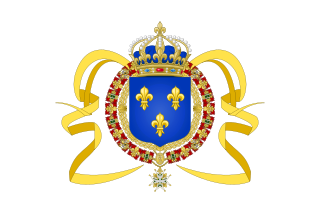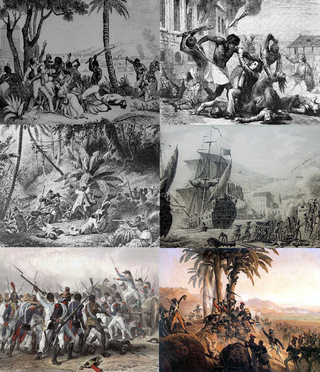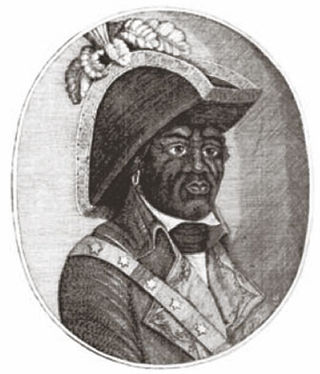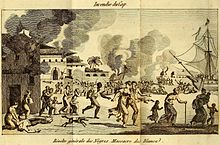
The Louisiana Purchase was the acquisition of the territory of Louisiana by the United States from the French First Republic in 1803. This consisted of most of the land in the Mississippi River's drainage basin west of the river. In return for fifteen million dollars, or approximately eighteen dollars per square mile, the United States nominally acquired a total of 828,000 sq mi in Middle America. However, France only controlled a small fraction of this area, most of which was inhabited by Native Americans; effectively, for the majority of the area, the United States bought the preemptive right to obtain Indian lands by treaty or by conquest, to the exclusion of other colonial powers.

François-Dominique Toussaint Louverture also known as Toussaint L'Ouverture or Toussaint Bréda, was a Haitian general and the most prominent leader of the Haitian Revolution. During his life, Louverture first fought and allied with Spanish forces against Saint-Domingue Royalists, then joined with Republican France, becoming Governor-General-for-life of Saint-Domingue, and lastly fought against Bonaparte's republican troops. As a revolutionary leader, Louverture displayed military and political acumen that helped transform the fledgling slave rebellion into a revolutionary movement. Along with Jean-Jacques Dessalines, Louverture is now known as one of the "Fathers of Haiti".

Jean-Jacques Dessalines was the first Haitian Emperor, and leader of the Haitian Revolution, and the first ruler of an independent Haiti under the 1805 constitution. Initially regarded as governor-general, Dessalines was later named Emperor of Haiti as Jacques I (1804–1806) by generals of the Haitian Revolutionary army and ruled in that capacity until being assassinated in 1806. He spearheaded the resistance against French massacres upon Haitians, and eventually became the architect of the 1804 Haitian Massacre against the remaining French residents of Haiti, including some supporters of the revolution. Alongside Toussaint Louverture, he has been referred to as one of the fathers of the nation of Haiti.

Saint-Domingue was a French colony in the western portion of the Caribbean island of Hispaniola, in the area of modern-day Haiti, from 1697 to 1804. The name derives from the Spanish main city on the island, Santo Domingo, which came to refer specifically to the Spanish-held Captaincy General of Santo Domingo, now the Dominican Republic. The borders between the two were fluid and changed over time until they were finally solidified in the Dominican War of Independence in 1844.

The Haitian Revolution was a successful insurrection by self-liberated slaves against French colonial rule in Saint-Domingue, now the sovereign state of Haiti.

George Biassou was an early leader of the 1791 slave rising in Saint-Domingue that began the Haitian Revolution. With Jean-François and Jeannot, he was prophesied by the vodou priest Dutty Boukman to lead the revolution.

Thomas Jefferson served as the third president of the United States from March 4, 1801, to March 4, 1809. Jefferson assumed the office after defeating incumbent John Adams in the 1800 presidential election. The election was a political realignment in which the Democratic-Republican Party swept the Federalist Party out of power, ushering in a generation of Jeffersonian Republican dominance in American politics. After serving two terms, Jefferson was succeeded by Secretary of State James Madison, also of the Democratic-Republican Party.

The Black Jacobins: Toussaint L'Ouverture and the San Domingo Revolution is a 1938 book by Trinidadian historian C. L. R. James, a history of the Haitian Revolution of 1791–1804.
The War of Knives, also known as the War of the South, was a civil war from June 1799 to July 1800 between the Haitian revolutionary Toussaint Louverture, a black ex-slave who controlled the north of Saint-Domingue, and his adversary André Rigaud, a mixed-race free person of color who controlled the south. Louverture and Rigaud fought over de facto control of the French colony of Saint-Domingue during the war. Their conflict followed the withdrawal of British forces from the colony earlier during the Haitian Revolution. The war resulted in Toussaint taking control of the entirety of Saint-Domingue, and Rigaud fleeing into exile.

Haiti–United States relations are bilateral relations between Haiti and the United States. Succeeding U.S. presidents refused to recognize Haiti until Abraham Lincoln. The U.S. tried to establish a military base in Haiti and invaded. It withdrew in 1934 but continued to intervene in Haiti during subsequent decades.

In the history of the Dominican Republic, the period of Era de Francia occurred in 1795 when France acquired the Captaincy General of Santo Domingo, annexed it into Saint-Domingue and briefly came to acquire the whole island of Hispaniola by the way of the Treaty of Basel, allowing Spain to cede the eastern colony as a consequence of the French Revolutionary Wars.

The Saint-Domingue expedition was a large French military invasion sent by Napoleon Bonaparte, then First Consul, under his brother-in-law Charles Victor Emmanuel Leclerc in an attempt to regain French control of the Caribbean colony of Saint-Domingue on the island of Hispaniola, and curtail the measures of independence and abolition of slaves taken by the former slave Toussaint Louverture. It departed in December 1801 and, after initial success, ended in a French defeat at the Battle of Vertières and the departure of French troops in December 1803. The defeat forever ended Napoleon's dreams of a French empire in the West.
Joseph R. E. Bunel was a representative of the Haitian Revolutionary Government, who negotiated the first trade agreement between his nation and the United States, in 1799.
Dr Edward Stevens FRSE was an American physician and diplomat. He was a close friend of American soldier and statesman Alexander Hamilton. Stevens' date of birth was unclear due to lack of records, with the year 1752 being published by Kristian Caroe, without sources, in his 1905 book Den danske lægestand, 1479-1900 until historian Michael E. Newton published contemporary records establishing Stevens birthplace and date.

The Indigenous Army, also known as the Army of Saint-Domingue was the name bestowed to the coalition of anti-slavery men and women who fought in the Haitian Revolution in Saint-Domingue. Encompassing both black slaves, maroons, and affranchis, the rebels were not officially titled the Armée indigène until January 1803, under the leadership of then-general Jean-Jacques Dessalines. Predated by insurrectionists such as François Mackandal, Vincent Ogé and Dutty Boukman, Toussaint Louverture, succeeded by Dessalines, led, organized, and consolidated the rebellion. The now full-fledged fighting force utilized its manpower advantage and strategic capacity to overwhelm French troops, ensuring the Haitian Revolution was the most successful of its kind.

The Le Jeune Case was a suit brought by 14 slaves against torture and murder by their master, Nicolas Le Jeune, in the French colony of Saint-Domingue in 1788. Le Jeune was accused of torturing and murdering six slaves, who he said had planned to poison him. Despite overwhelming evidence of Le Jeune's guilt, courts ruled in favor of the planter, demonstrating the complicity of Saint-Domingue's legal system in the brutalization of slaves. The Haitian Revolution ending slavery in Saint-Domingue would begin only three years later.

The Law of 4 February 1794 was a decree of the French National Convention which abolished slavery in all French colonies.
The French revolutionary government granted citizenship and freedom to free people of color in May 1791, but white planters in Saint-Domingue refused to comply with this decision. This was the catalyst for the 1791 slave rebellion, a key event for the Haitian Revolution with which the new citizens demanded their granted rights.
Moyse Hyacinthe L'Ouverture was a military leader in Saint-Domingue during the Haitian Revolution. Originally allied with Toussaint L'Ouverture, Moyse grew disillusioned with the minimal labor reform and land distribution for black former slaves under the L'Ouverture administration and lead a rebellion against Toussaint in 1801. Though executed, the insurrection he directed highlighted the failure of the Haitian Revolution in creating real revolutionary labor change and ignited the movement that drove L’Ouverture from office.

Thomas Jefferson took office in 1801 after defeating incumbent President John Adams in the 1800 presidential election. By July 1801, Jefferson had assembled his cabinet, which consisted of Secretary of State James Madison, Secretary of the Treasury Albert Gallatin, Secretary of War Henry Dearborn, Attorney General Levi Lincoln Sr., and Secretary of the Navy Robert Smith. Jefferson sought to make collective decisions with his cabinet, and each member's opinion was elicited before Jefferson made major decisions. Gallatin and Madison were particularly influential within Jefferson's cabinet; they held the two most important cabinet positions and served as Jefferson's key lieutenants. During Jefferson's administration, the key foreign policy concerns revolved around relationships with the major European powers, particularly the United Kingdom, France, and Spain—each of which continued to hold substantial territories in North America—and with conflicts with the Barbary pirates.
















